




Dear caregivers,
In this edition, we are thrilled to share some incredible news. Thanks to the extraordinary generosity of a local donor, we have received a $150,000 donation for St John of God Langmore Centre. This donation is a testament to the unwavering support of our community and will play a pivotal role in transforming Stephenson House into a contemporary space which will allow us to meet the evolving needs of our community mental health and wellbeing programs.
The funds will specifically support the redevelopment and refresh of Stephenson House, enabling us to expand our range of services including day programs, support groups, educational events for medical professionals, and crucial training such as Mental Health First Aid and ASIST (Applied Suicide Intervention Skills Training). This initiative will not only enhance our capacity to provide vital mental health support but also ensure our facilities are conducive to learning, healing, and growth for all those we serve.
On August 3 we celebrate the second anniversary of St John of God Langmore Centre. Over the past two years, we have dedicated ourselves to providing exceptional mental health care and support to our community. It has been a journey filled with compassion, growth, and impactful outcomes. We have expanded our services, and launched innovative programs to make a difference for those who live in the South East Melbourne region and beyond.
As we reflect on this journey, we are reminded of the incredible strides we have made together. From offering comprehensive mental health programs, introducing new
Psychiatrists and services, to organising educational workshops, every initiative has been guided by our commitment to holistic care and community well-being.
In addition to celebrating our anniversary and the transformative donation received, we are thrilled to recognize the amazing work of our caregivers at St John of God Berwick Hospital and St John of God Frankston Rehabilitation Hospital. Recently, our teams came together to provide exceptional care for several palliative patients who are younger than our typical demographic. This collaborative effort includes nurses, PCAs, environmental caregivers, catering caregivers, pastoral care practitioners, and doctors and exemplifies our values-led approach. It demonstrates the profound impact we can achieve when we work together. It shows the impact each and every caregiver can make, contributing to our mission of delivering compassionate and excellent care.
Thank you for being part of our South East Melbourne community and for your contribution. Together, we continue to uphold the highest standards of care and support for all individuals who rely on our services.
Lisa Norman

In a fast paced realm of healthcare, the Day Procedure Unit (DPU) at th Berwick Hospital stands as a critical hub where efficiency and teamwork play pivotal roles. This article explores the intricacies of a very busy day in DPU highlighting the importance of patient experience and satisfaction in this fast paced environment.
A typical day in DPU is characterised by a whirlwind of activities from admissions to discharges. Nurses, doctors and all other healthcare professionals navigate tight schedules with precision. The unit operates like a well-oiled machine, with staff collaboration seamlessly to ensure each patient receives optimal care.
Despite the hectic pace, the focus on patent experience remains paramount. The journey begins with pre admission phone calls, where patients are educated about the process, expectations and any necessary preparations. Clear and compassionate communication helps to alleviate anxiety, fostering sense of trust between patients and healthcare professionals. The model of care in DPU has been adopted to meet the demands of a busy schedule without compromising quality. Patient centred care is prioritised, ensuring that individuals feel supported and informed throughout their journey.
In DPU, the team extends beyond individual capabilities to the collective synergy of the entire unit. A DPU team is characterised by a harmonious blend of expertise, adaptability and a shared vision for excellence. The diverse skills and perspective within the team create an environment where challenges are met with innovation and each member feels empowered to contribute their best.
Efficiency is the heartbeat of a Day Procedure Unit. Streamlined processes, meticulous planning and effective communication among the team contribute to a smooth workflow. Timely interventions and precise coordination between different departments enhance the overall experience for patients who often appreciate the seamless transition of their care.
Measuring the patient satisfaction is integral to continuous improvement. Feedback mechanisms, surveys and patient testimonials provide valuable insights. Understanding the factors that contribute to satisfaction allows procedure and enhance the overall patient experience. Continuous improvement and feedback mechanisms are embedded in the DPU model of care.
A very busy Day Procedure Unit is a testament to the dedication of healthcare professionals who navigate the challenges of a fast paced environment. It exemplifies the delicate balance between efficiency and compassion. Its success hinges on the commitment of a well-coordinated team and the adoption of patient centred model of care. By prioritising the patient experience and satisfaction, this unit create a balance between efficiency and empathy, ensuring that every patient receives not only excellent medical care but also a positive and reassuring experience throughout their journey.
By Aji Flower, DPU Nurse Unit Manager

With almost 40 years serving the medical needs of others, it’s hard to imagine that John Monagle really didn’t grow up with a dream or solid plan to become a doctor.
“Much like most of my career I just fell into it,” says John, who worked his last shift after retiring as Director of Medical Services at St John of God Berwick Hospital on May 31 this year. “It was just a thing to do when I finished school,” he laughs.
Despite not having an ambition to work in the medical field, John admits to loving the roles and the path his career has taken even though much of its direction was a result of chance instead of well-thought out objectives he set out to achieve.
“I never planned to get into anaesthesia, I was just offered a job after being in the right place at the right time,” says John who ended up working as an anaesthetist at the Gibb Street location after a colleague reached out to him for help covering the odd shift.
Similarly, John’s career progression into specialising in pain management came about because of the lack of medical professionals available to care for people with chronic pain when he was working at Dandenong Hospital in the late 1990s.
“Again, I just slid into pain management by chance,” says John. Not surprisingly, his move into hospital administration in 2014 as medical director, “was also an accident. It just seemed like a good idea at the time,” he adds.
What was never left to chance however was his decision to primarily take on roles and/or operate his private practice from within a hospital environment. “I always enjoyed working with people — both patients and caregivers alike. Patient contact and listening to people’s stories was something I really liked and hospital environments are usually warm, welcoming and fun. St John of God in particular was always full of good people.”
Setting up his private practice within the hospital meant that there were always people from diverse backgrounds and roles for John to talk to and learn about. “Even when I was finishing up in my practice late at night, there’d be cleaners there to have a chat with — I loved the daily interaction,” says John who admits that working as part of a team and helping patients get through difficult times is something he will miss most when he leaves.
“I’ll definitely miss the patient contact. It’s incredibly rewarding to help a patient through a hard time. As well as being part of a team who are all working toward the same objective.”
While much of John’s career decisions may appear to have been made on a whim at times, retirement was not one of
those choices that he fell into easily. “Loretta [John’s wife] had been at me for about three years to consider retirement but the challenge for me was – it’s hard to know when it’s the right time to make a decision to stop doing something you love.”
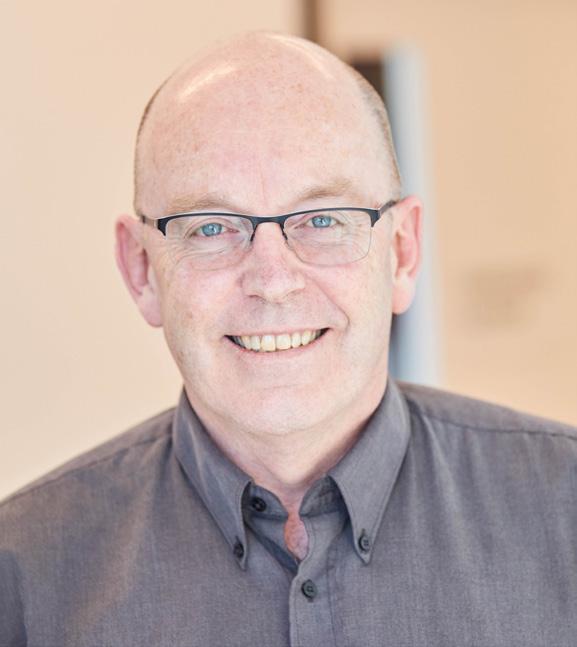
John explains, “I’m not nervous about retiring. I’d rather retire when I’m well, rather than because I’m unwell, but it’s sad to be leaving a job I love knowing that when a doctor retires, it’s a permanent decision that you can’t just choose to come back to whenever you want.”
When asked about the changes he’s seen over the past four decades in practice, John reflects that while there have been small alterations in the way care is delivered across different specialities the biggest one that springs to mind is the changes in pre-op care.
“We used to admit patients to hospital the night before scheduled surgery. Doctors would do their rounds, meet their patients, help put them at ease and administer pre-op meds where needed. We used to get 24 hours to make our patients comfortable, where now we only get 15 minutes.”
John adds that, “It’s not necessarily a bad thing though. Good doctoring and nursing is about taking the time with patients, however that doesn’t mean taking time unnecessarily. Shorter hospital stays are better for the patient overall and being in an unfamiliar environment, away from family, friends and routine can create the anxiety that we used to medicate patients for. I think it’s a good change.
So what does somebody who doesn’t make plans, plan to do in retirement, you may wonder? “We’re going to take the train ride from Adelaide to Darwin. But that was actually organised before I decided to retire, so it probably doesn’t count,” he jokes.
Other than that, the only concrete plans John has is a Wiggles concert with his four-year-old granddaughter in July. “It’s been 20 years since I’ve been to a concert,” shares John. “And 30 years since I went to see the Wiggles with my son at the same age. I don’t really know what else I’m going to do. I have four children and one of them lives in England so maybe a visit there next?”
If past behaviour is a good predictor of future behaviour then whatever John does decide to do in his retirement — it’s unlikely he, himself will know what that is until he accidently decides to do it.

Linda Allen is adamant that if she went back in time and surveyed her old classmates during her learning days, they would never have picked her to be the one to attain success through a variety of leadership roles in health care.
With a passion for culture and allowing people to speak and be heard, Linda attributes much of her leadership success to her ability to give team members autonomy over decision-making, and by doing so, the opportunity to find new ways of doing things.
“I didn’t always seek out opportunities to take on management roles,” explains Linda. “But oftentimes I was given a chance, so I took it.”
These opportunities were, however, sometimes met with hesitation. “When I returned from maternity leave earlier in my career, I began to lean toward positions that were more education-oriented or project-role type work. At first I was concerned that I’d miss the patient-interaction part of being a nurse but I soon realised that I would instead get that same people interaction by working with other staff members. As long as I was able to watch people grow and learn, I was happy.”
Spanning over 40-years, Linda’s career has seen her take on a number of different roles including as director of clinical and corporate services but cites two projects that have brought her the most satisfaction overall.
“I led a project to establish a nurse bank for a group of 10 hospitals. This included the introduction of an IT system and lots of change management. Part of my role was to convince each hospital team of the benefit this project would provide to them, despite the resistance of these hospitals to initially cooperate and share with each other, it was a great success.”
As a testament to Linda’s success – after more than a decade in operation, the project continues to run today.
Although Linda admits that her time as CEO of Pinelodge Clinic and Langmore Centre was quite challenging, especially during the Covid years, her role in moving the existing Pinelodge hospital in Dandenong, to its new location on Gibb Street in Berwick was a career defining moment for her.
“The opportunity to design a new facility and relocate a hospital and its people into a new space is not something that comes along often,” Linda claims. “So it certainly has become a highlight of my career and something I’m very proud to have been involved in.”
With retirement looming for Linda, it’s a career achievement that ends her career on a high…if of course, she does retire, that is.
While the purpose of this article was to celebrate Linda’s career and announce her retirement, Linda has hinted at the
possibility of reconsidering that idea if another “accidental opportunity” presented itself.
“When I turned 60 I began to consider what age would be the right time for me to retire. If I were to live to 90 – I’d still have 30 years left and that made me think I was too young to call it quits, but then a lovely friend of mine reminded me that I might only live to 70, so it changed my outlook a bit.”

Unfortunately for Linda, the decision to retire came a little sooner than planned when she unexpectedly found herself caring for a family member over the past few months.
“I have always said that decisions shouldn’t be made when your head is not in the right place, but I feel like the timing is right at this moment,” says Linda, who adds, “It was a tough position to be in when I still really enjoyed work and my job.”
For now, Linda plans to spend time with her family, in particular her two-year-old grandson. She also intends to invest her free time in her love of painting, drawing, history and art and hopefully will also include some travel.
“I enjoy the intellectual stimulation I get from work. So until I figure out what else I might like to do, I’ve taken up investigating my family tree as a way of ensuring my problemsolving skills don’t go to waste in the meantime,” she laughs.
St John of God Health Care thanks Linda for her dedication and contribution to the success of our workplace. We wish her well on her future endeavours.
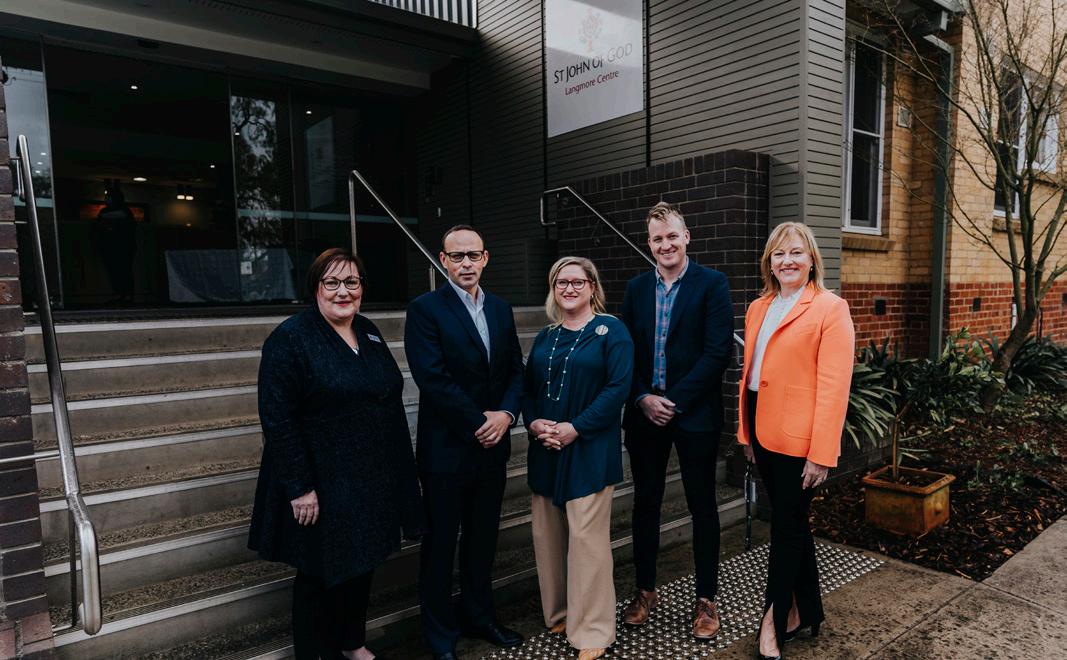

St John of God Health Care Group Marketing have traditionally worked with SEM to produce a bi-annual photoshoot. However, due to the Covid-19 lockdowns, the last SEM photoshoot was in 2018!
Well overdue for some new imagery in our marketing materials, Jayne Stanley, Group Content Marketing and Communications Coordinator visited Melbourne in May to work along-side Lisa Carman, SEM Marketing and Communications Manager to produce a new library of images for both St John of God Berwick Hospital and St John of God Langmore Centre. St John of God Frankston Rehabilitation Hospital was the exception, having been the subject of a more recent hospital-specific photoshoot in 2021.
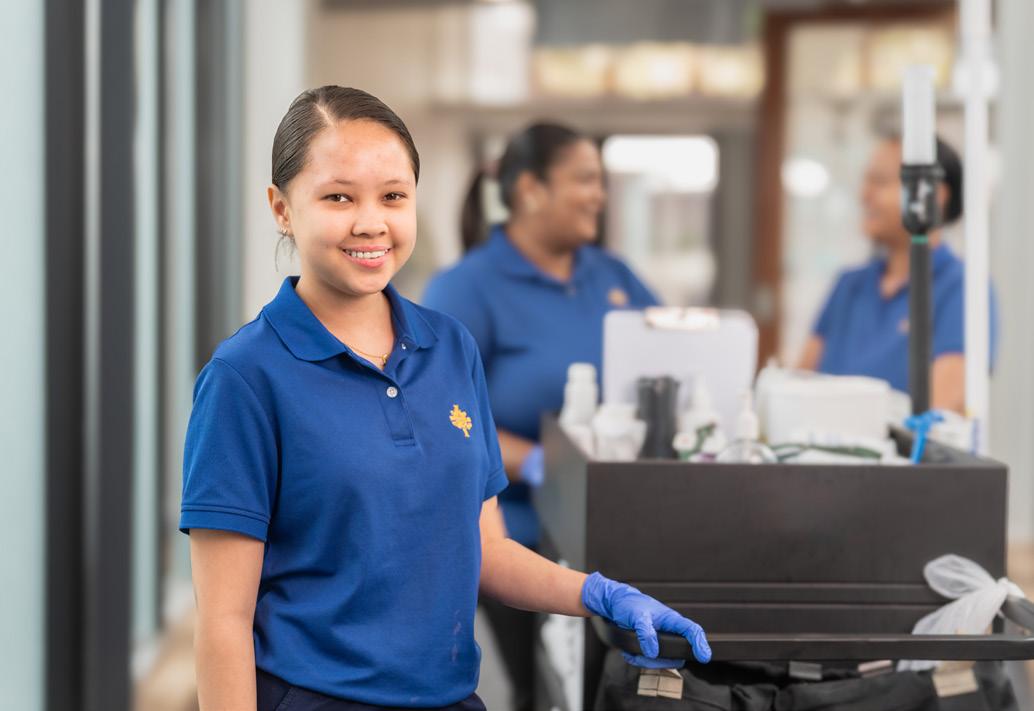
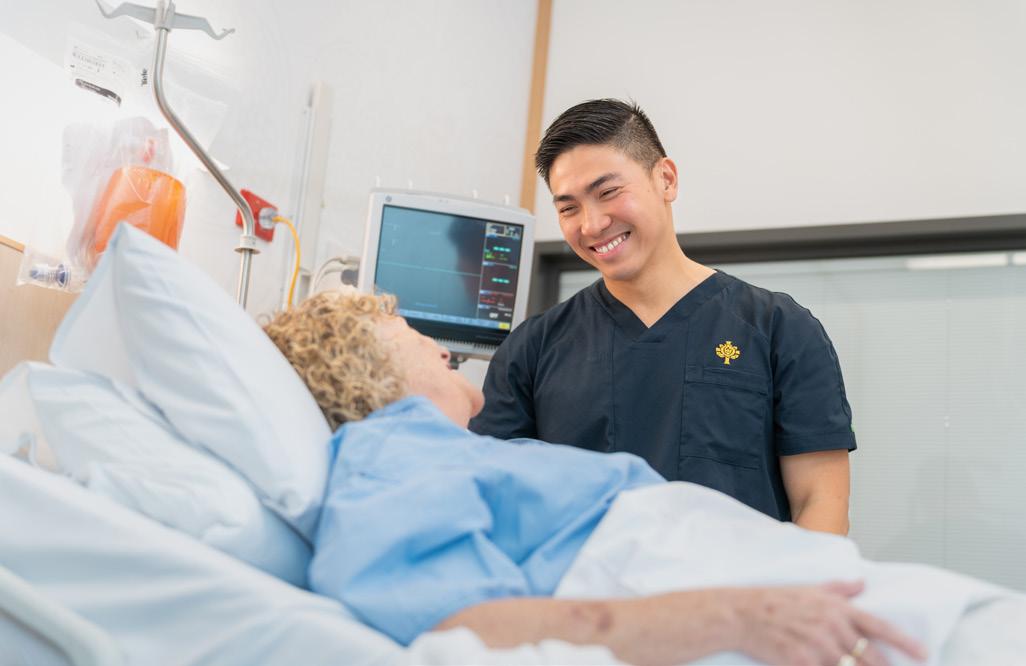

Caregivers and volunteers from both hospitals were willing participants in the photos, and demonstrated their warmth and compassion which was caputres so beautifully by photographer, Michelle.
The photography suite is used in a variety of ways and you will begin to see these new photos in digital campaigns, brochures, on posters, social media and more!
A very big thank you to all the caregivers who supported the marketing team and stepped out of their comfort zone and in front of the camera.
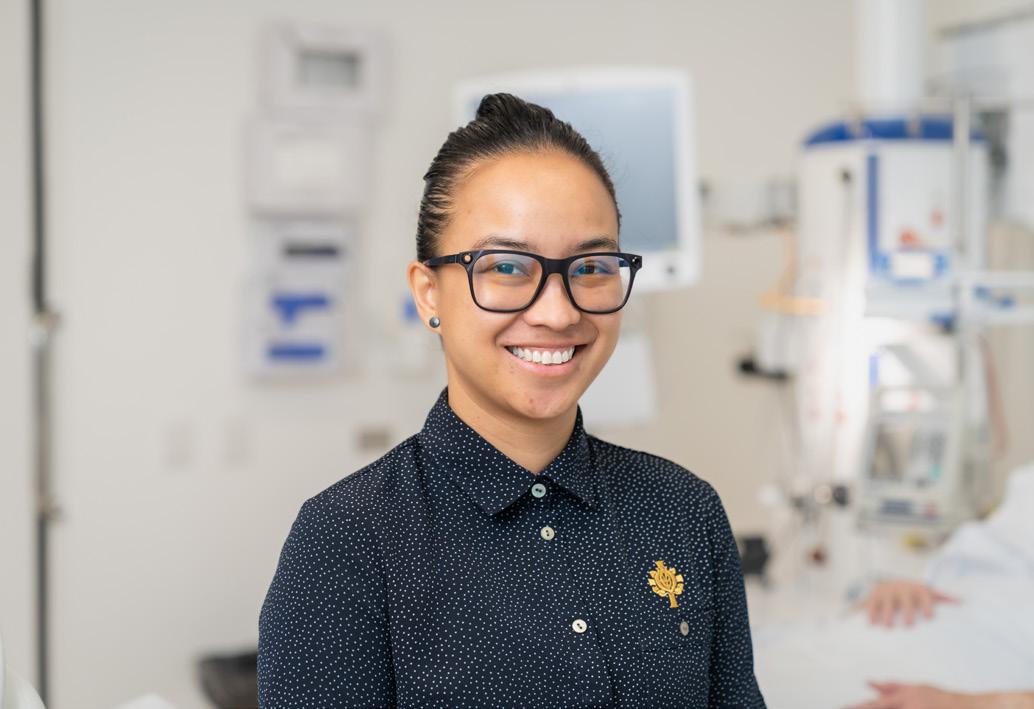







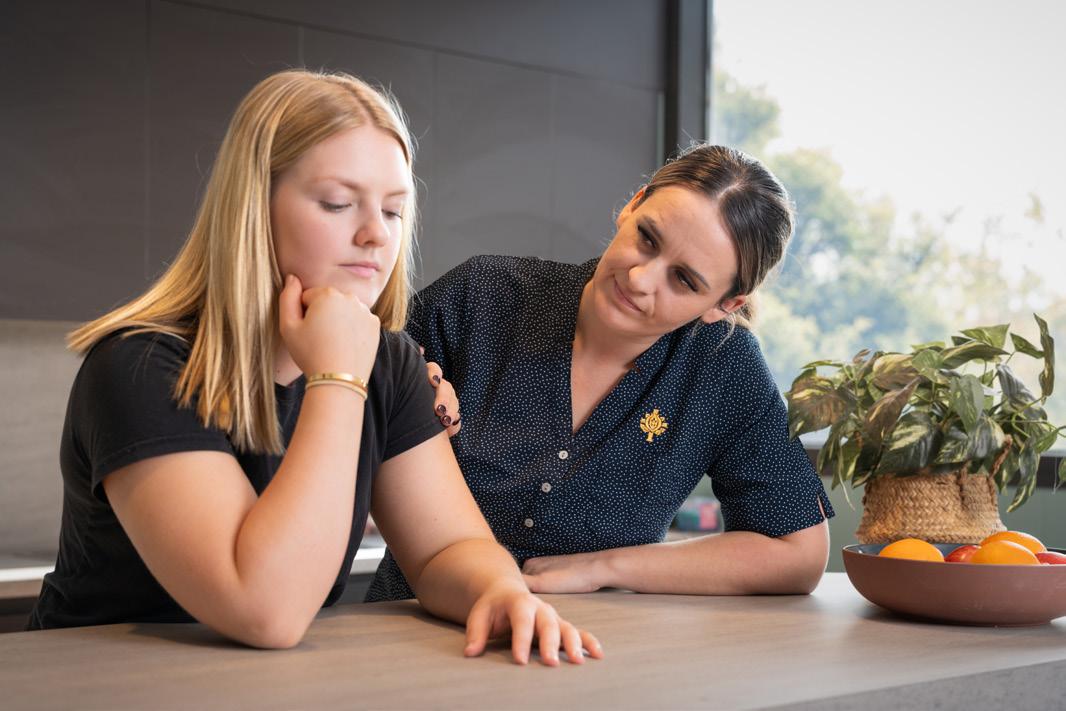
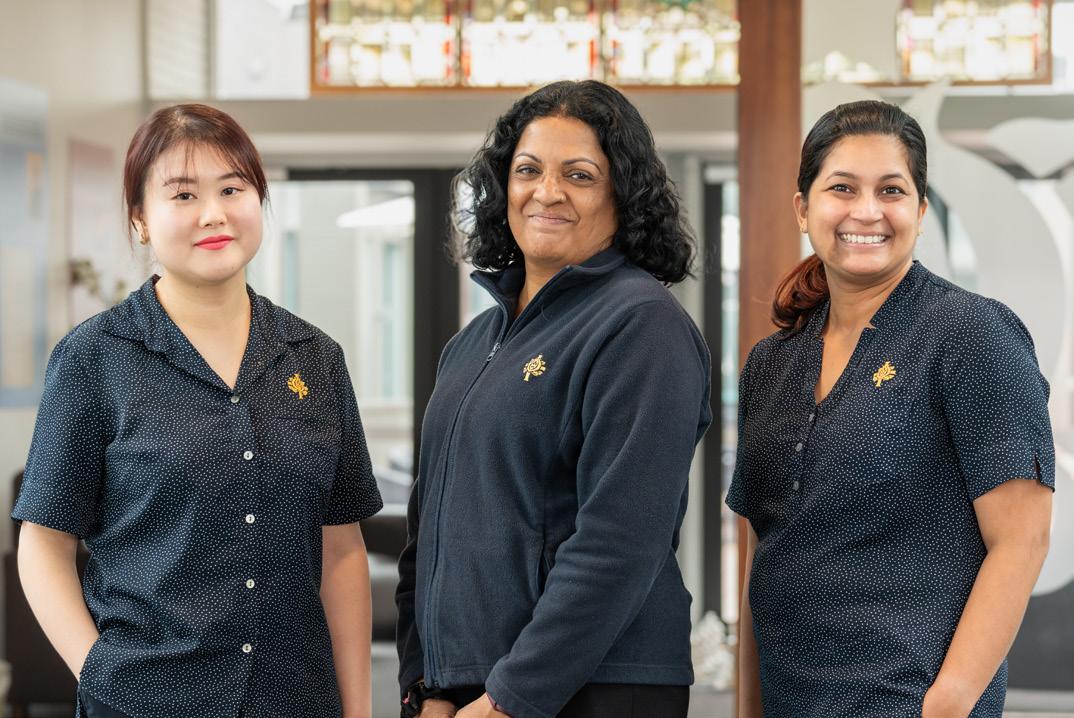
Lippincott Procedures by Wolters Kluwer were implemented on July 1 across 10 of our sites, including Warrnambool, Bendigo, Berwick, Ballarat, Geelong, Geraldton, Bunbury, Murdoch, Mt Lawley, and Midland, both private and public.
This is a significant advancement in our clinical skills education and resources at St John of God Health Care.
Lippincott Procedures is an evidence-based online resource that offers step-by-step guidance for clinical procedures. These procedures undergo a rigorous double-blind peer review process in partnership with the Australian College of Nursing (ACN). They are customised to Australian nursing protocols, regulations, terminology, and drug names, and are mapped to the NSQHS Standards to ensure high-quality care.
Here are some key benefits:
• Standardised Best Practices: Access to evidence-based clinical skills education
• Integration with Ausmed: Reflect and log CPD hours directly to your Ausmed account, simplifying professional development tracking.
• Comprehensive Library: 24/7 online access to a growing library of over 440 procedures, with 26 more procedures planned for release in 2024.
Lippincott Procedures will not replace our existing St John of God Health Care procedures. Instead, it will support education and skill development.

Our Innovate Reconciliation Action Plan (RAP) for 2024 – 2026 outlines St John of God Health Care’s continued commitment to reconciliation and our intent to build on our meaningful partnerships and opportunities with Aboriginal and Torres Strait Islander peoples over the next two years and beyond.
Through our Innovate RAP 2024 - 2026 we will demonstrate leadership in health and community care service provision and use our influence to recognise our shared responsibility in closing the gap in Aboriginal health care.
Through our journey of reconciliation, we will be inspired by cultural learning and truth

telling to connect deeply with Aboriginal and Torres Strait Islander communities where our hospitals and services operate.
Through our reconciliation focus areas we will continue to celebrate First Nations peoples and cultures, grow our community partnerships, enhance and pursue progress within the areas of employment and the provision of culturally safe health and community care services that deliver improved outcomes for Aboriginal and Torres Strait Islander people.
You can view the RAP by visiting CORA.


In an attempt to invite new patients into the hospital to experience its welcoming and hospitable care, St John of God Langmore Centre have hosted their first Creative Art for Wellness workshop.
Held in the evening, the two-session workshop was attended by 12 participants from the community who were keen to experience the benefits of art therapy.
The sessions cost $50 and did not require the participant to have private health insurance.
Given the huge success of the first sessions and the rapid rate at which it program sold out, the Langmore team are in the process of setting further dates and exploring other similar community workshops.
Keep your eyes peeled for details!
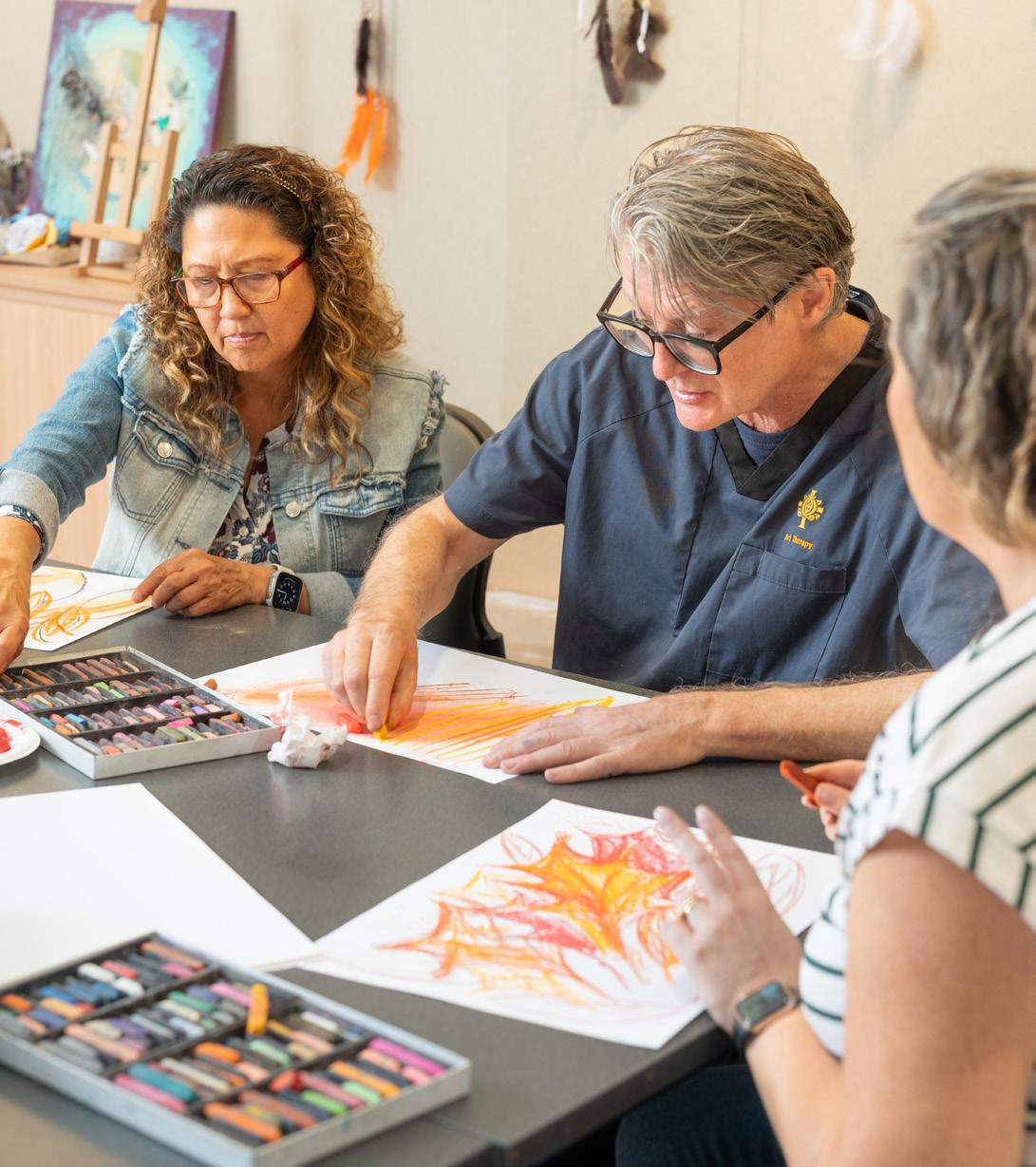
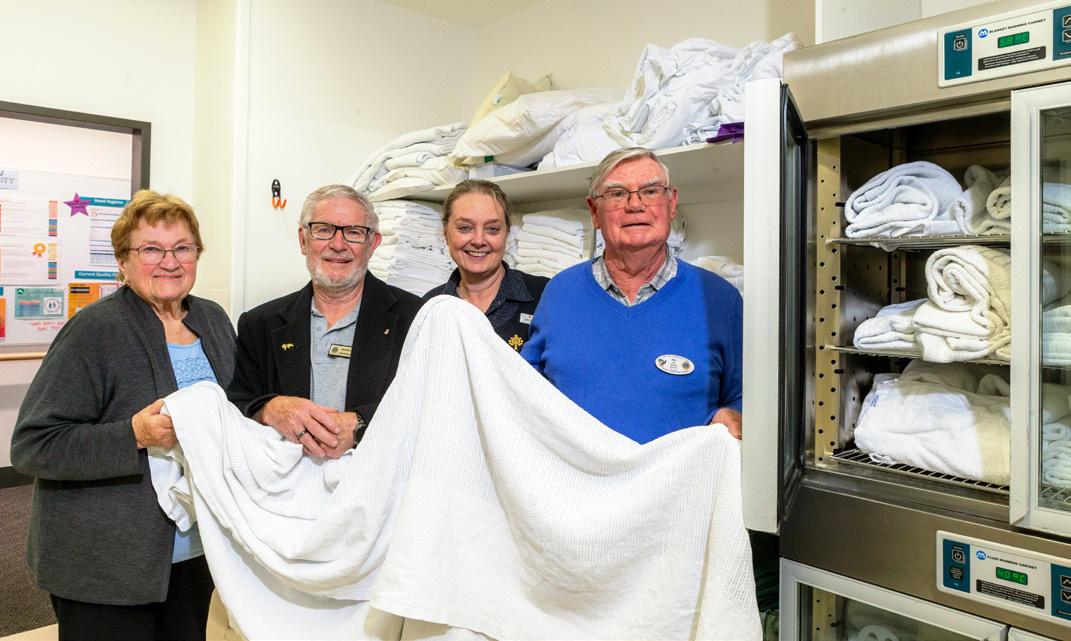
St John of God Berwick Hospital palliative care patients now have access to warm blankets instantly, thanks to funding from local Lions clubs towards a new blanket warming cabinet.
Clubs from across the region, including Casey Hills Lionesses, Hampton Park and Pakenham, supported the cause with a $4000 donation raised via their regular fundraising activities, including sausage sizzles and cake sales over the past 12 months.
St John of God Berwick Hospital Director of Nursing Allison Merrigan said, “Donations to the hospital are always greatly valued both in the impact they have on our patients and the care we provide.“
“It’s like getting a warm hug from someone.“

A reminder to all Berwick caregivers to park your cars on carpark level B2. By keeping level B1 vacant for our patients, we offer the best patient experience by making their visit more convenient and less stressful.
Thank you for your support in showing hospitality to all who visit our hospital.

The Starfish Program began back in December 2019 when then seven year-old Chien visited St John of God Berwick Hospital for life-changing surgery to his badly deformed legs with Professor Ton Tran, Orthopaedic Surgeon.
Born with a condition called talipes (known as clubfeet), both of Chien’s feet were permanently turned inward and parallel to the ground, making walking impossible.
Occurring in about 1 in 1100 births the condition is not overly rare. In developed countries babies are routinely fitted with orthotics days after birth so their legs selfcorrect before they are ready to take their first step.
But Chien was born in the village of Nam Khoa, high in the mountains near Vietnam’s northern border with China. The village is a one hour trek to the nearest road, and then a then a 14 hour drive to Hanoi. Having only his grandmother, the village also seemed a world away from help until the principal of a school 40km away offered the chance of an education.
During school terms Chien has slept at the homes of his teachers including Vy Tran, while classmates carried him on their backs to help him get around. Determined to do more for Chien, Ms Tran and others appealed for help.
The appeals were heard by Prof Tran, who spent weeks undertaking online video consultations before pleading with St John of God Berwick Hospital chief executive Lisa Norman.
Having brought hundreds of children to Australia for lifechanging surgery, Children First Foundation was brought on board to help Chien get to Melbourne and the surgery was undertaken by Prof Tran at St John of God Berwick Hospital.

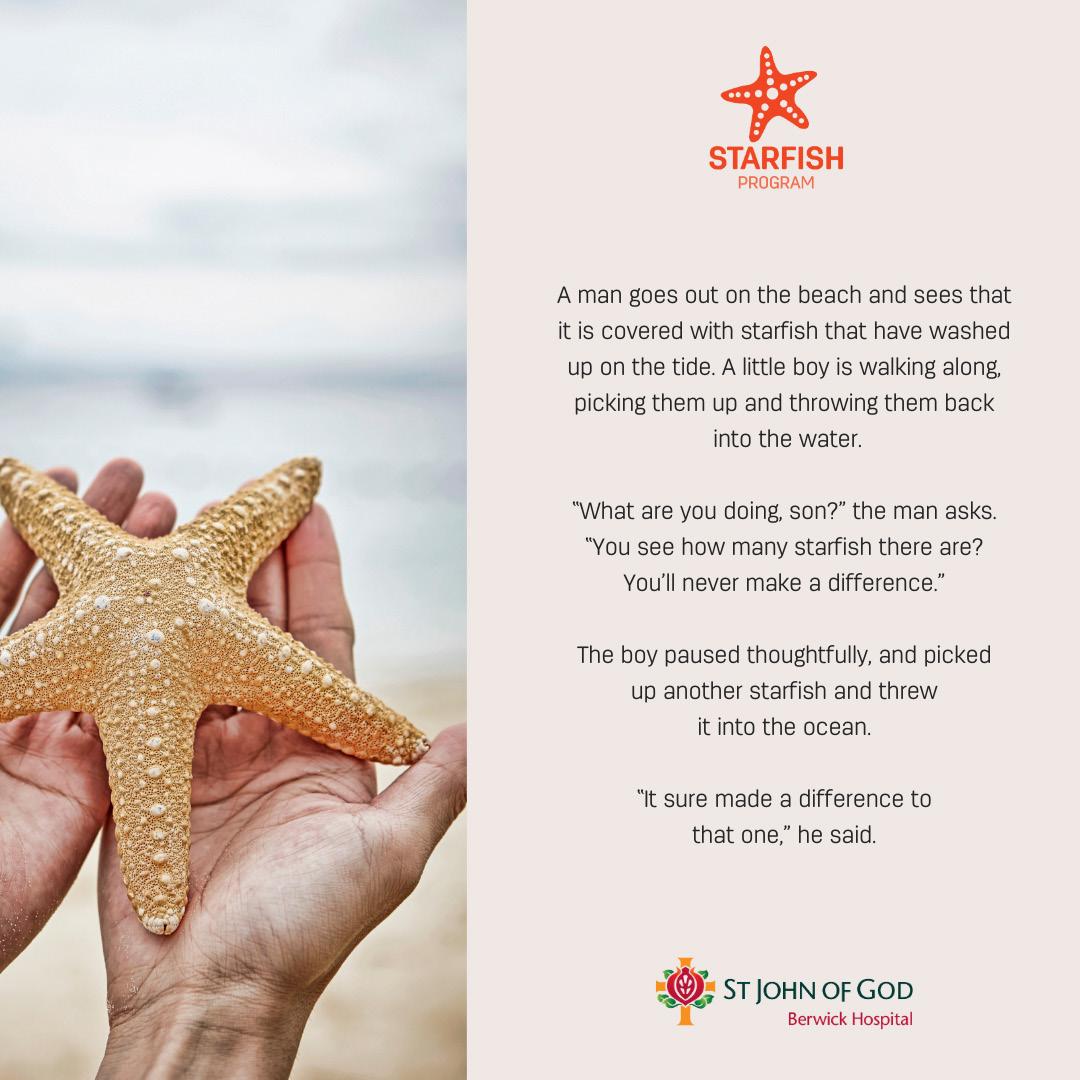
Chien went home to Vietnam, recovered well but now needs a secondary procedure on his hip. We expect to see him back at the Berwick Hospital sometime in the near future fo this procedure.
Since Chien’s visit the hospital, along with Children First, have helped Garisha from Vanuatu and Lendyta from Papua New Guinea with various life-changing procedures and enabled them both to go home with a brighter future.
Nine year-old Sang, also visited from Vietnam in June for surgery to his feet with Prof Tran correcting his talipes and enabling him to walk.
With the number of cases growing, the St John of God Berwick Hospital team felt it time to give these acts of good-will a name and formally create a program, now called the Starfish Program.
We look forward to playing our role in changing the lives of more children in need.

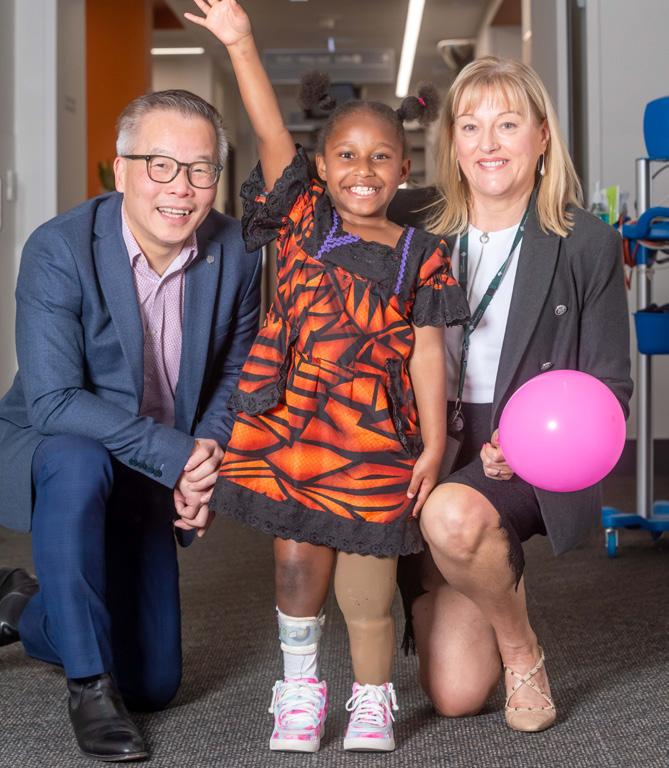



Well done to the Berwick Day Oncology team, who raised $505


Congratulations to the Frankston team, who raised $611

St John of God Berwick Hospital has begun hosting monthly Pregnancy Information Sessions, inviting the community in to meet the midwives and obstetricians and take a tour of the maternity unit.
The sessions allow guests to ask all their burning questions and better understand the two models of pregnancy care on offer: private obstetrics and the lower cost JOY model.
The initiative is part of a bigger maternity strategy which sees the hospital promote its obstetricians and support them in gaining obstetric patients at a time when the Australian private health care system is going through challenge and change.
The full room at each session and the positive feedback is a good indication that the sessions are just what the doctor ordered!
Scan to view upcoming dates and book:
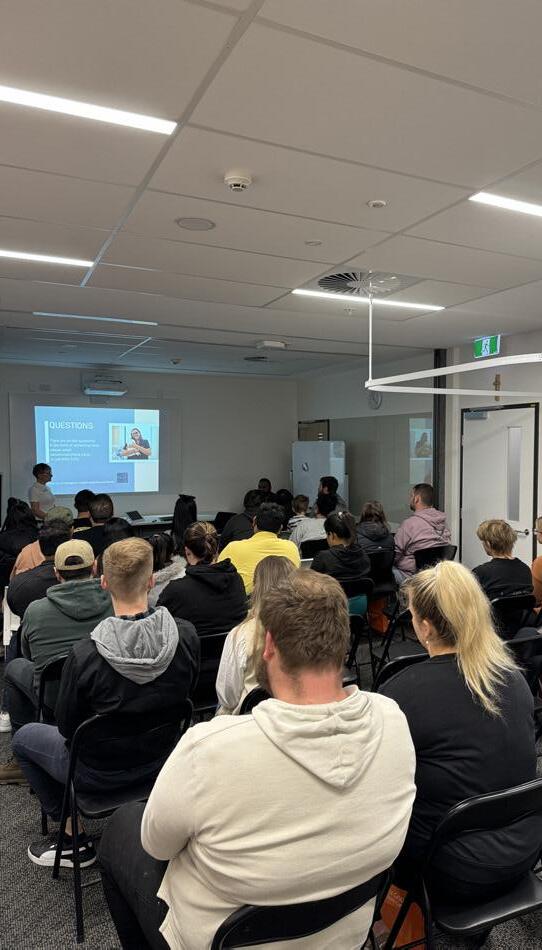

May 20-26
The South East Melbourne volunteer team were celebrated and thanked at a garden party held at St John of God Langmore Centre during May’s National Volunteer Week.
The event was a cheery affair with many smiles and laughs and a general feeling of immense gratitude for the selfless people who choose to spend their time assisting our caregivers and patients, making our hospitals happier places to be. St John of God Health Care is truly grateful for each of them.


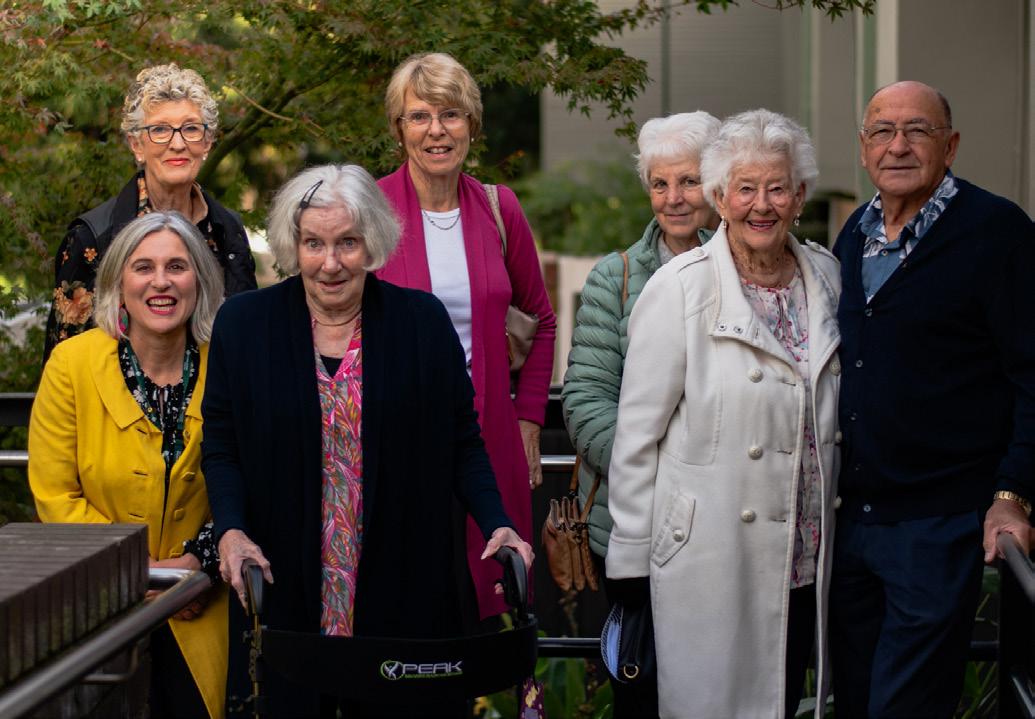
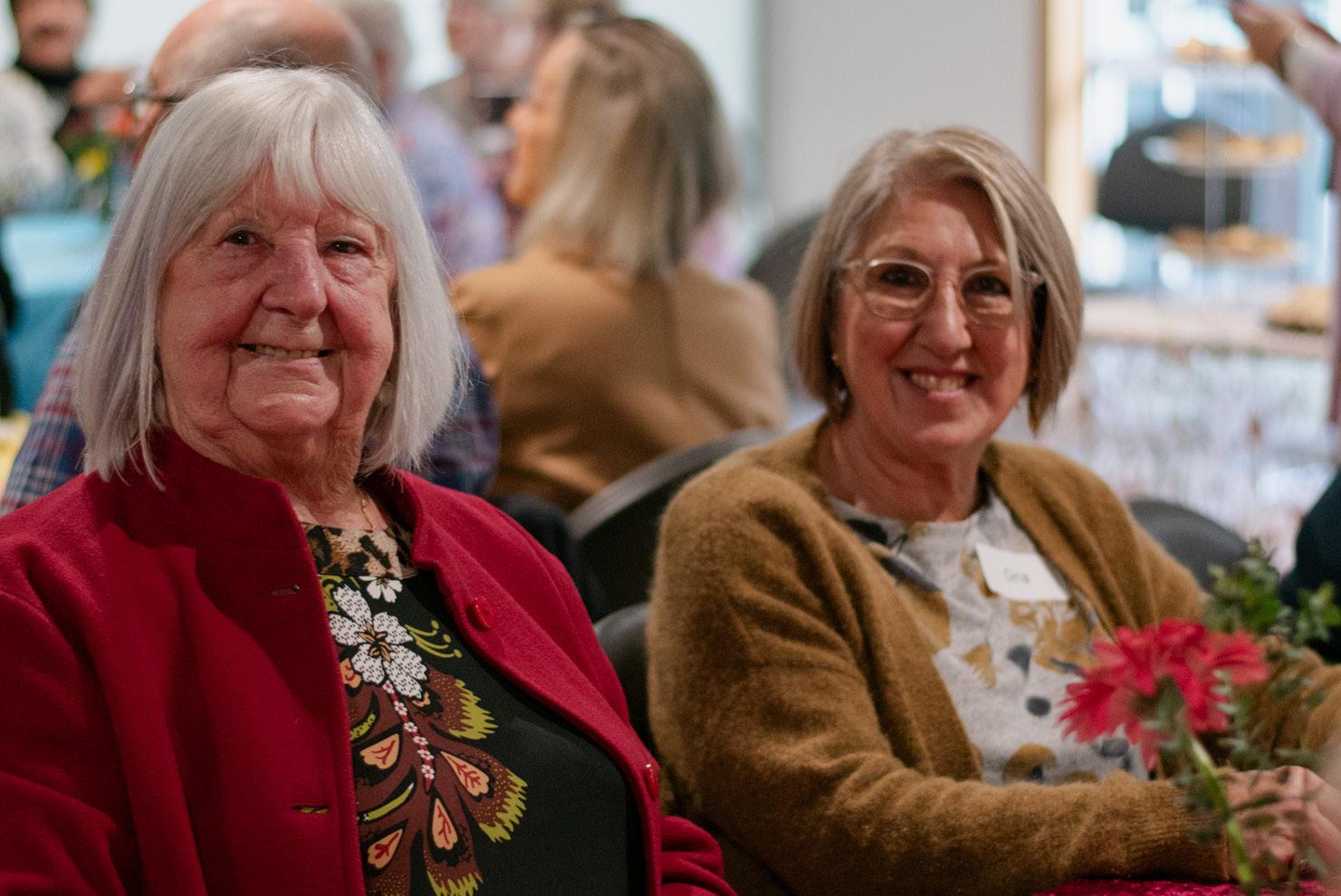
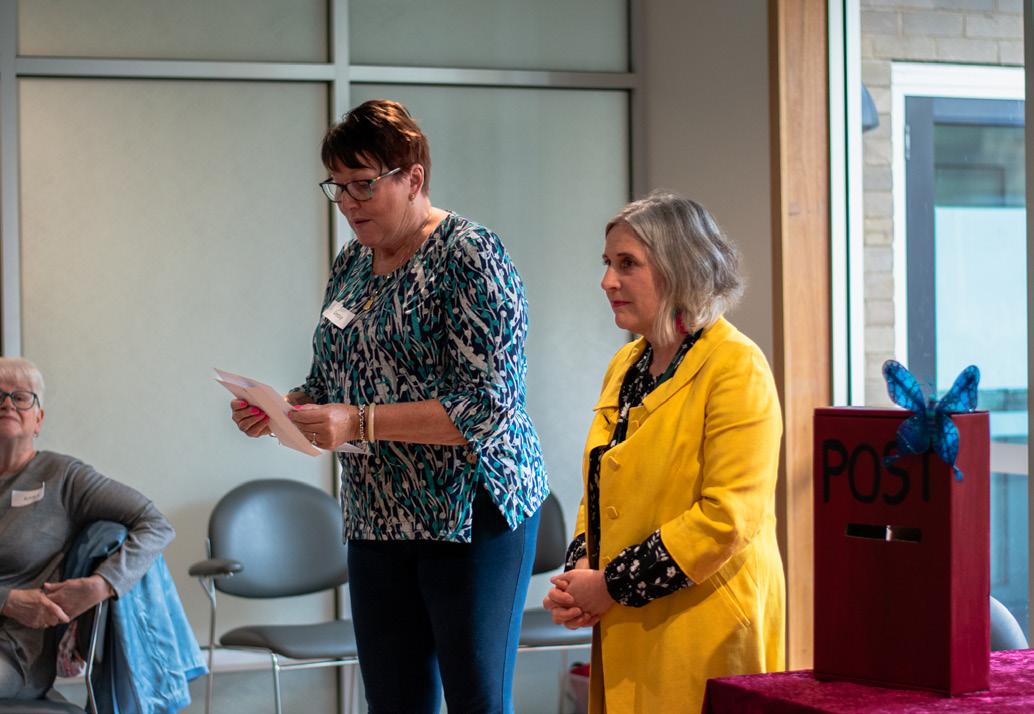
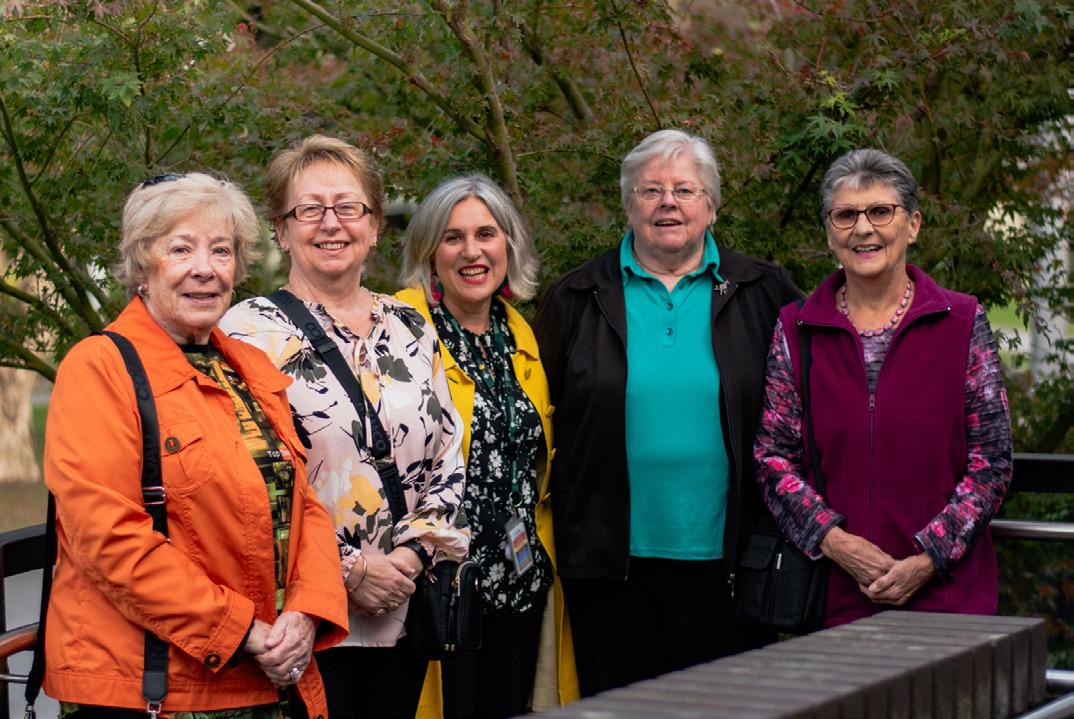


Above: Erica Proposch, SEM Volunteer Coordinator
What you must never do is stand between an oncology volunteer and their shift. They are team not to be messed with. They will tell you it is essential that they are there and it is the honest truth. They are a vital ingredient to the excellence in care provided in day oncology with their warm, caring, sensitive, good humoured and respectful hospitality.
At SJG Berwick we have a dedicated, compassionate and fun bunch of volunteers helping in oncology every week. They are devoted to Lisa Marchetti, Nurse Unit Manager, the caregivers and patients. What is brilliant is that when you speak to a volunteer there is no doubt that there is receiving in the giving.
Let’s hear from Helen, oncology volunteer:
I was born into a medical family in Sheffield, UK, shortly after WW2. My Dad often took me with him on his house calls and hospital rounds, and I loved going with him, especially when his patients gave me chocolate. We often visited the factories which made Sheffield steel and silver; there he monitored employees for possible lung problems. As a young child I met the rich, the poor and those from every walk of life. I had a great introduction to the medical world and I loved how my Dad took care of his patients.
Once, we visited a dedicated shingles ward in hospital. My Dad’s elderly patient had shingles on her face and in her eyes; I was told she may go blind and I was frightened for her, she looked very troubled. Months later I was privileged to see a hip operation, an experience I didn’t really understand. After that I vowed I would never have either shingles or hip surgery, but I’ve had both. Thankfully, the treatments and surgeries have been fine-tuned in the past 70 years.
I really longed to follow my Dad’s calling, but maths was an essential subject for medicine and, sadly, maths and I never understood each other. However, my younger son has successfully achieved my dream.
Fast forward to my semi-retirement and I needed to give back to the community. I looked at a few volunteer options but nothing ticked even half of the boxes. I wanted to help, to make a difference, interact personally and have a sense of belonging, preferably in the medical world. It seemed to be a very tall order. Playing tennis one day I met Sue Holland, a SJG volunteer. We chatted about volunteering, that was it. Since then, my life has been blessed in many ways and through great friendships.
I volunteer in oncology where the atmosphere is warm and welcoming from both the nursing caregivers and patients. Meeting and chatting with caregivers and patients is fun, and we are constantly told how much we are appreciated. I began there in 2017 and, during COVID, I struggled because we had to stop. Before COVID there were two volunteers per shift; now there is one, which can make serving snacks and hot drinks together quite challenging. But there’s a saying, “If you want something done, ask a busy person.”
Oncology patients need treatment for weeks/months and often a bond is formed with volunteers. I remember one elderly gentleman who had a liking for a particular snack and lunch, and he often spent ages chatting to me. If the caregivers asked him if he’d like something to eat or drink, he’d say “No, ask Helen to come and see me, she knows”. I wonder how and where he is now.
My parents always taught me to be there for others. Whilst I may have given my time and energy to SJG, I have also received much more than I have ever given. I love what I do. My world has expanded; my confidence has grown, and I take on challenges more easily. I am blessed to be in good health and able to help. I pray this continues for many years.
Thank you to Helen and all the committed volunteers in day oncology. We appreciate and value you.
By Erica Proposch, Volunteer Coordinator.

“When you are a caregiver, you know that every day you will touch a life or a life will touch yours.” — Unknown
Despite working independently in his own practice, medical oncologist Dr Cam McLaren, enjoys the camaraderie he feels working alongside St John of God Health Care colleagues and caregivers – so much so, that he cites it as being one of the main reasons he chooses to consult exclusively within the organisation’s hospital network.
“Working on my own can be a very isolating experience at times but the staff at St John of God are very supportive and certainly make me feel like part of a team even though I don’t actually officially belong to one,” jokes Dr Cam.
It takes more than an oncologist to meet the varying needs of cancer patients. And it’s especially difficult when a patient becomes terminal and is approaching end-of-life care. While Dr Cam is well versed in managing the medical side of his patients’ diagnoses, he’s the first to admit that in order to provide the individual care needed, he relies upon the values of St John of God Health Care to deliver treatment in a way that best aligns with his own personal beliefs and professional approach.
“For example, a lot of stuff needs to happen in cases where treatment options have been exhausted and a patient decides they’d prefer to pass away in the comfort of their own home, surrounded by their loved ones,” says Dr Cam. “There is such a short window of time available to ensure a decision like that can be supported safely and efficiently. Oftentimes, unfortunately, hospitals are unable to priortise coordinating the team needed to facilitate such a request before a patient becomes too unstable to be moved.”
Dr Cam explains that it takes the combined effort of caregivers, physios, OTs, doctors and family members to not only enable a transition home, but specifically for it to occur within the limited timeframe available to do so. “Each step in the method of assessment and management of logistics can delay the process and things can become very unsafe, very quickly for patients,” he admits. “The last thing you want is for a patient to pass away en route in an ambulance without the people they need around them or in the place they
are hoping to be when it happens.”
“There’s a tendency within the medical community when someone is really sick, to say that the person’s situation is best managed in hospital. Even from a doctor’s perspective — it’s difficult to relinquish control over their care, knowing that you and their care team are best suited to provide the best medical care to them. However, it’s fair to say that in times like these, it’s not actually the medical care that’s needed, or even wanted the most, by the patient at that point. And for that reason alone, I am grateful for the support I receive from St John of God Health Care to tailor care in a way that sits well with my own expectations and is of course, in the best interests of my patient,” states Dr Cam.
“Because this organisation hires well, they employ the right people who have a good, individual approach to what a person needs — even if that breaks away from tradition methods of hospital care,” says Dr Cam, adding that, St John of God Health Care is dedicated to ascertaining what is best for the patient and goes out of its way to give it to them.
While this focus enables the hospital to differentiate itself from standard practices, Dr Cam does not operate strictly within the confinements of what is expected of him professionally either. As was the case when Dr Cam met Hayley Fyfield — a 40-year-old mother with limited options available to fight her cancer diagnosis.
“Hayley was pretty much dying when she presented to me for care. She had a very nasty breast cancer that didn’t play by the rules. Cases like hers are rare but we generally expect to be able to treat this cancer well enough to prolong life by three to seven years in most cases. Unfortunately for Hayley her cancer transformed very aggressively and while we really couldn’t do anything to better tackle her situation, we were able to buy her an extra 16 months through the specialised care provided that addressed her individual needs.”
“Kirsten [CEO of Breast Cancer Network Australia], commented to me that in her time with BCNA she has rarely seen an oncologist attend a funeral,” said Paul Fyfield, Hayley’s husband — who added that Kirsten [Pilatti] “has vast experience in helping people navigate the medical system when dealing with their cancer treatment and was so impressed with everything Dr Cam and the team at St John of God Berwick Hospital did for us.”

“Every time we lose someone, it’s significant,” says Dr Cam. “But when it’s someone so young, leaving behind a family with little kids, dying before their parents … it really stands out. The fact that we couldn’t do much after having no response from a few different approaches, it was hard not to recognise the magnitude of their situation.”
Dr Cam admitted that he really connected with Paul and Hayley. And while he understood that attending the funeral of a patient is not common practice among medical professionals, he simply explained that he felt very grateful in having an organisation like St John of God Health Care support him in choosing to deliver a style of care that is important to him even if it might at times stray from the norm.
“I tread the line of professional care delicately. And I was pleased, but not at all surprised, to see other caregivers from the hospital at Hayley’s funeral also. I mean we see a lot of our patients on a weekly basis – I don’t even see my closest friends that often,” Dr Cam points out.
When it became clear that Hayley’s passing would soon be inevitable and her wish to die at home communicated, Dr Cam said, “everybody pulled up
stumps and worked both tirelessly and unitedly to make it happen.”
That effort was not at all lost on Paul and his young family. Soon after Hayley passed away at home with Paul holding her hand, he contacted Dr Cam to say he was immensely grateful for the care his whole family had received, also acknowledging the hospital’s offer to fund counselling sessions for himself and their children in the aftermath of her death.
“And at the funeral — to the many people there with only standing room left available — Paul spoke glowingly about the care Hayley had received through St John of God, even thanking individual carers in the process,” shares Dr Cam. “This is why I won’t work anywhere else. I just haven’t felt that heightened sense of connection in any other place I’ve worked so far.”
“I know that there is a balance to be found between running a financially viable hospital and providing individually focused care — but when a choice has to be made — in my experience St John of God Health Care has always sided with what constitutes best patient care every single time.”
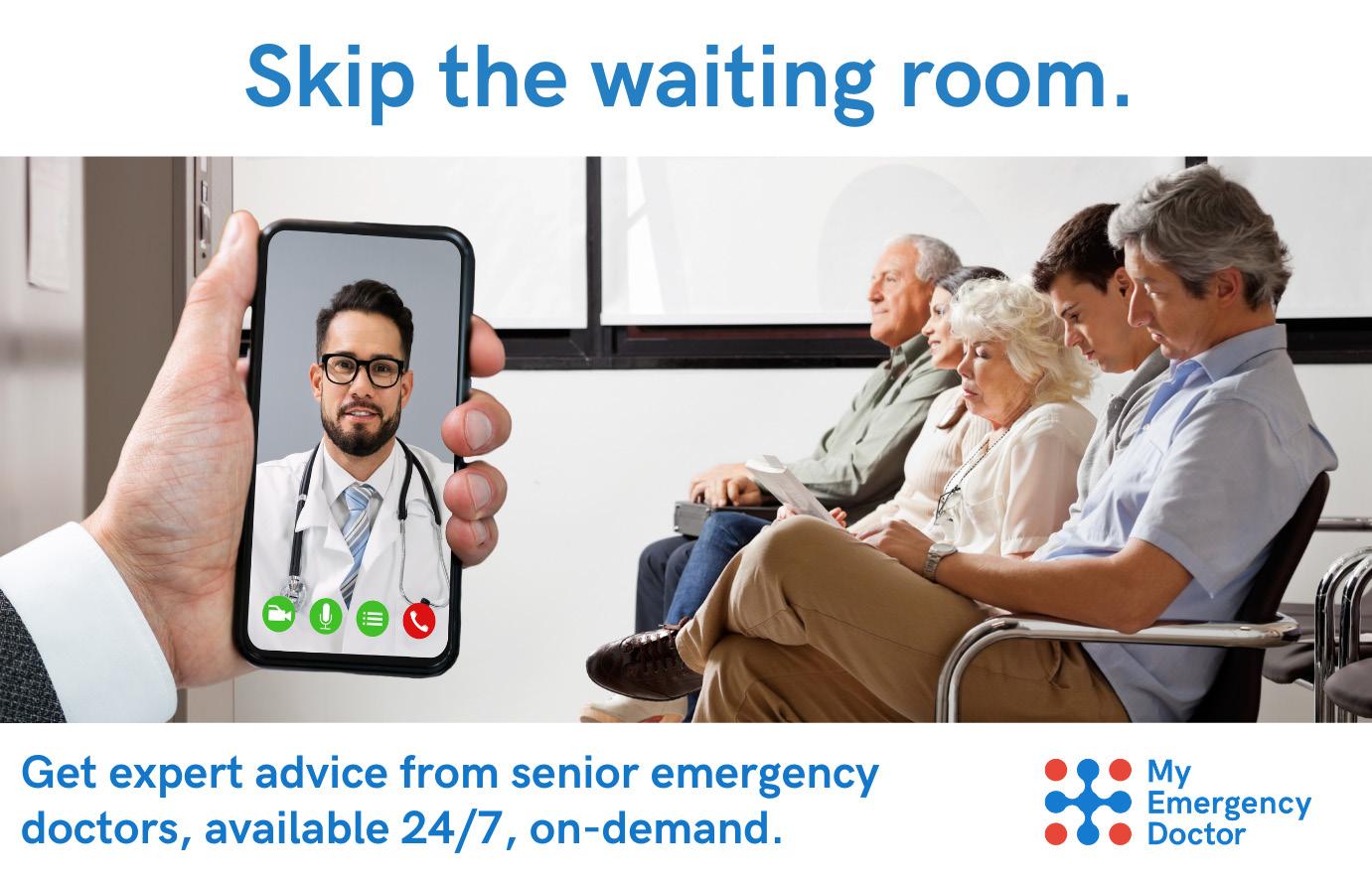
Patients- including your family and friends- now have quick access to urgent care from the comfort of their own home via My Emergency Doctor’s (MED) telehealth service which is linked on the St John of God Berwick Hospital website.
If patients are unwell, have an urgent medical issue, and are thinking about attending an emergency department or their GP is unavailable, then MED can support them to receive medical advice and treatment.
• My Emergency Doctor (MED) is a telemedicine service providing access to emergency specialists via phone or video call.
• Patients can talk to MED’s senior doctors from home regarding the medical problem they are experiencing, allowing them to avoid waiting in a hospital emergency department.
MED offers medical advice and treatment to patients from the comfort of their own home, including:
• referrals to medical specialists
• referrals to allied health professionals
• referrals to medical imaging and pathology
• e-scripts for medications.
The cost to use MED is $220 (Medicare do not fund this service. If patient is directly admitted to St John of God Berwick Hospital, fee is refunded).
Hospital admission
If MED’s doctors believe the patient needs admission to hospital they can refer directly to St John of God Berwick Hospital. Our caregivers will organise admission under the patient’s usual specialist, or a specialist available to accept admissions.
GP reporting
The patient’s clinical report will be available for GPs via My Health Record.
Patients can access MED via the St John of God Berwick Hospital website, QR code or by calling 1800 491 756
